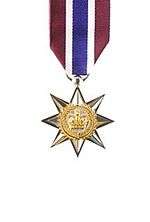New Zealand Gallantry Star
| New Zealand Gallantry Star | |
|---|---|
 Obverse of the medal. Ribbon: 32mm, crimson with a purple central stripe flanked by narrower white stripes. | |
| Awarded by New Zealand | |
| Type | Military decoration. |
| Eligibility | New Zealand and allied forces. |
| Awarded for | "acts of outstanding gallantry in situations of danger" while involved in war and warlike operational service (including peacekeeping). |
| Status | Currently awarded. |
| Description | 45mm, (Obverse) faceted silver eight-pointed star of equal points surmounted by the Royal Crown and fern frond wreath emblem; (reverse) inscribed "FOR GALLANTRY - MO TE TOANGA". With ring suspension. |
| Statistics | |
| Established | 20 September 1999 |
| Total awarded | 5 |
| Precedence | |
| Next (higher) | Companion of The New Zealand Order of Merit[1] |
| Next (lower) | New Zealand Bravery Star[1] |
The New Zealand Gallantry Star (NZGS) is the second level military decoration of the New Zealand armed forces.
It was instituted by Royal Warrant on 20 September 1999[2] as part of the move to replace British gallantry awards with an indigenous New Zealand Gallantry system. The medal, which may be awarded posthumously, is granted in recognition of "acts of outstanding gallantry in situations of danger" while involved in war or warlike operational service (including peacekeeping).
Bars are awarded to the NZGS in recognition of the performance of further acts of gallantry meriting the award. Recipients are entitled to the postnominal letters NZGS.
This medal replaced the award of the Distinguished Service Order (when awarded for gallantry), the Distinguished Conduct Medal, and the Conspicuous Gallantry Medal.
Recipients
- Colonel Neville John Reilly, ONZM, New Zealand Army; year of award: 2000. Reilly served with the United Nations Mission in East Timor (UNAMET) between June and September 1999. He was responsible for the security of the United Nations Mission while East Timor was in a state of anarchy, and displayed exceptional courage in the face of physical threat from militia forces.[3]
- Corporal Albert Henry Moore, Royal New Zealand Infantry Regiment; year of award: 2011. Moore was the commander of a vehicle of a New Zealand Provincial Reconstruction Team patrol when it was ambushed by insurgent forces in the Bamyan Province of Afghanistan on 3 August 2010.[3]
- Corporal David Steven Askin ("Serviceman D"), New Zealand Special Air Service; year of award: 2014. Askin displayed gallantry on several occasions in Afghanistan in 2011. He repeatedly faced heavy fire from determined enemies and sustained several wounds, while contributing to the resolution of several incidents, including the 2011 Inter-Continental Hotel Kabul attack, during which he was wounded by grenade and rifle fire, yet carried on and rescued guests from the hotel as fire broke out.[4] Askin later died in the crash of the helicopter he was piloting in fighting the 2017 Port Hills wildfires in Christchurch, New Zealand.[4]
- "Serviceman J", New Zealand Special Air Service; year of award: 2014. He attended the 2011 Inter-Continental Hotel Kabul attack in Afghanistan in 2011, in which he demonstrated gallantry and leadership under heavy fire from a determined enemy, contributing to the resolution of the incident and the protection of comrades and civilian life.[5]
- Major Geoffrey Michael Faraday, Royal New Zealand Armoured Corps; year of award: 2015. Faraday defended United Nations facilities in South Sudan from attacks over the period 17 to 29 April 2014.[6]
See also
Notes
- 1 2 "Order of Wear: Orders, Decorations and Medals in New Zealand". Department of the Prime Minister and Cabinet. Retrieved 20 January 2013.
- ↑ "New Zealand Gallantry Awards". Department of the Prime Minister and Cabinet. Retrieved 15 February 2017.
- 1 2 "Recipients of the New Zealand Gallantry Star". New Zealand Defence Force. Retrieved 15 February 2017.
- 1 2 "Helicopter pilot was decorated soldier" (Press release). New Zealand Defence Force. Scoop. 15 February 2017. Retrieved 15 February 2017.
- ↑ Brownlee, Gerry (9 December 2014). "Gallantry Awards recognise NZSAS". New Zealand Government. Retrieved 15 February 2017.
- ↑ "Breaking medals news". New Zealand Defence Force. Retrieved 15 February 2017.
References
- Mackay, J and Mussel, J (eds) - Medals Yearbook - 2005, (2004), Token Publishing.